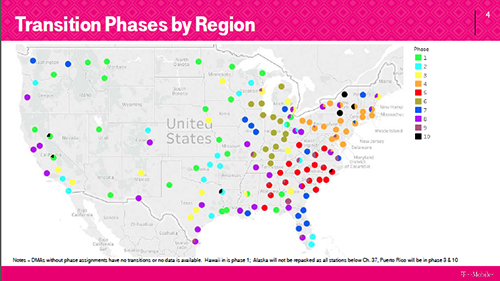T-Mobile Paints Rosy Repack
WASHINGTON—T-Mobile says the government’s TV channel-repacking methodology will beat expectations.
“Likely less than 800 full-power TV stations will need to be repacked. It appears the FCC’s repacking optimization was better than T-Mobile and other participants in the proceeding anticipated,” the carrier said in an ex parte presentation to Federal Communications Commission staff members March 30. (Click on image for .pdf of presentation slides.)
T-Mobile’s latest estimate stands in contrast to the number proffered by the FCC last October, which put the number of TV stations that will have to move to new channels at the 84 MHz clearing target at 1,274, though T-Mobile makes no mention of Class A stations, and neither take count as many as 3,150 LPTVs and translators.
The wireless carrier and likely forward auction winner of reclaimed TV spectrum noted that it made calculations “based on information supplied by licensees and publicly available material.”
“T-Mobile has assembled transition data on more than 1,000 broadcaster licenses. Using the FCC’s SAT-based Feasibility Checking software, it’s possible to make educated guesses about the status of remaining unknown broadcasters,” the presentation states.
T-Mobile calculated that fewer than 800 “full-power” stations will need to be “repacked;” fewer than 700 towers will need to be modified; and fewer than 200 broadcasters will move from UHF to VHF.
The carrier has long been at odds with the National Association of Broadcasters over the 39-month repack deadline, with the NAB asking for more flexibility and T-Mobile insisting 39 months is sufficient.
“T-Mobile and others have exhaustively documented how the broadcasting ecosystem can meet the demands of the broadcast-relocation process within the 39-month timeframe the FCC has adopted for clearing the 600 MHz band,” the carrier said in a May 31, 2016 filing.
AT&T, another likely spectrum winner, was less certain about the 39-month timeframe though never technically opposed it. Instead, AT&T’s Joan Marsh emphasized the complexity of the repack in a March 14, 2016 filing and suggested looking to the 800 MHz transition as an object lesson.
“The 800 MHz rebanding effort began with the belief that the band could be fully re-organized within 36 months,” she wrote. “We now know, in hind sight, that the effort will in fact take more than a decade to complete.”
Marsh suggested assigning a Transition Administrator for the repack, similar to what was done for the 800 MHz reorganization of public safety radio users and wireless providers. Coincidentally, the most recent 800 MHz TA quarterly report was filed April 5 with the FCC, indicating that coordination along the Mexican border still continues 12 years into the reorganization.
In its most recent repack filing, T-Mobile offered to help where it could and urged the FCC’s Incentive Auction Task Force to provide “clarity and assurance” to broadcasters. The carrier also gave a shout-out to non-coms and indies as “most in need of transition assistance.”
The carrier further noted that ERI, its repack antenna partner, “has indicated they can assemble, tune, QC, and ship an FM aux antenna for FM broadcasters in a single day.” It is not yet known how many FM licensees share tower space with TV stations and may be affected by the repack. The Corp. for Public Broadcasting alone said it has 191 stations in the repack zone. T-Mobile said it was “working to determine the number of FM stations collocated with transitioning TV broadcasters.”
T-Mobile also urged the commission to let broadcasters who relinquished their full 6 MHz be allowed to go off the air early, and alluded to a “second construction permit window” in which broadcasters could expand their coverage beyond the current 1 percent threshold. In accordance with the FCC’s Post Auction Transition Scheduling Plan issued Jan. 27, 2017, construction and modification permit applications are due 90 days after the FCC issues its “Auction Closing and Channel Reassignment Public Notice,” around mid-April.
Finally, the carrier asked that data on linked station sets be included in the PN, and for clarification on how to notify different types of broadcast facilities in the event of interference to a new 600 MHz wireless neighbor.
T-Mobile’s team met with several FCC staff members, including individuals from the Media Bureau, the Office of Engineering and Technology and the Incentive Auction Task Force.
Also see…
March 17, 2017
“NAB Seeks Repack Reconsideration”
The NAB and others in the broadcasting community have long held this 39-month window is insufficient to move as many as 1,274 full-power and Class A TV stations—notwithstanding as many as 3,150 low-power TV and translator licensees—into the 16 remaining TV channels.
Feb. 6, 2017
“FCC Updates TVStudy Repack Software”
TV IX check mode is said to support the 1 percent coverage contour increase and the 5 percent population decrease thresholds to be used during the first 90 days after the Incentive Auction Closing and Channel Reassignment Public Notice is released in the coming weeks.
March 15, 2016
“AT&T Supports Regional Repack”
The 800 MHz rebanding involved a repack of public safety radio users in spectrum adjacent to cellular frequencies. AT&T, expected to be one of the biggest buyers in the upcoming TV spectrum incentive auction, wants to take possession of that spectrum as soon as reasonably possible.
Sept.. 26, 2014
“T-Mobile: 84 MHz of UHF Spectrum Can Be Reclaimed With Limited Impact on TV”
Fewer than 400 stations—representing less than 20 percent of all existing licensed broadcasters, many of them outside of the major markets—need to participate in the incentive auction to clear 84 MHz of spectrum for broadband use.”

Get the TV Tech Newsletter
The professional video industry's #1 source for news, trends and product and tech information. Sign up below.
